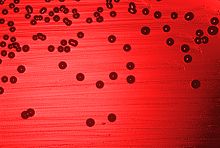- Haemophilus
-
Not to be confused with Haemophilia.
Haemophilus 
Haemophilus influenzae on a blood agar plate. Scientific classification Kingdom: Bacteria Phylum: Proteobacteria Class: Gammaproteobacteria Order: Pasteurellales Family: Pasteurellaceae Genus: Haemophilus
Winslow et al. 1917Species H. aegyptius
H. aphrophilus
H. avium
H. ducreyi
H. felis
H. haemolyticus
H. influenzae
H. parainfluenzae
H. paracuniculus
H. parahaemolyticus
H. pittmaniae
H. somnus
etc.Haemophilus is a genus of Gram-negative, pleomorphic, coccobacilli bacteria belonging to the Pasteurellaceae family.[1][2] While Haemophilus bacteria are typically small coccobacilli, they are categorized as pleomorphic bacteria because of the wide range of shapes they occasionally assume. The genus includes commensal organisms along with some significant pathogenic species such as H. influenzae—a cause of sepsis and bacterial meningitis in young children—and H. ducreyi, the causative agent of chancroid. All members are either aerobic or facultatively anaerobic.
Contents
Metabolism
Members of the Haemophilus genus are typically cultured on blood agar plates as all species require at least one of the following blood factors for growth: hemin (factor X) and/or nicotinamide adenine dinucleotide (factor V). Chocolate agar is an excellent Haemophilus growth medium as it allows for increased accessibility to these factors.[3] Alternatively, Haemophilus is sometimes cultured using the "Staph streak" technique: both Staphylococcus and Haemophilus organisms are cultured together on a single blood agar plate. In this case, Haemophilus colonies will frequently grow in small "satellite" colonies around the larger Staphylococcus colonies because the metabolism of Staphylococcus produces the necessary blood factor by-products required for Haemophilus growth.
See also
References
- ^ Holt JG (editor) (1994). Bergey's Manual of Determinative Bacteriology (9th ed.). Williams & Wilkins. ISBN 0-683-00603-7.
- ^ Kuhnert P; Christensen H (editors). (2008). Pasteurellaceae: Biology, Genomics and Molecular Aspects. Caister Academic Press. ISBN 978-1-904455-34-9. [1]. http://www.horizonpress.com/past.
- ^ Ryan KJ; Ray CG (editors) (2004). Sherris Medical Microbiology (4th ed.). McGraw Hill. ISBN 0-8385-8529-9.
External links
- Haemophilus chapter in Baron's Medical Microbiology (online at the NCBI bookshelf).
Categories:
Wikimedia Foundation. 2010.
